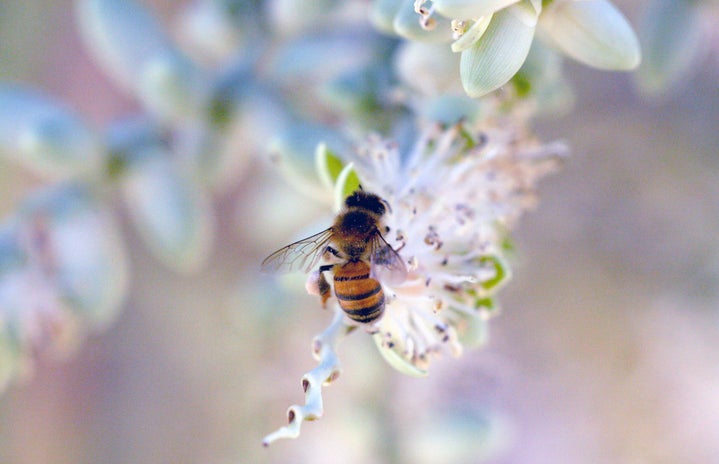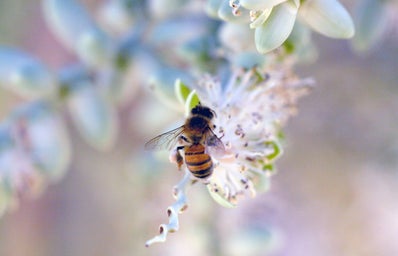Do you guys remember when Buzz the Bee was cropped out from Cheerio boxes temporarily in 2017? This decision, made by the corporation General Mills, was made to raise awareness of pollinator decline, which included packets of wildflower seeds to promote planting pollinator-friendly plants. With news articles being published, and 12-year-old me being appalled by the declining bee population, the campaign definitely made an impact. Little me thought: “Is honey going to be gone forever?” How could I live without my peanut butter and honey sandwiches? But little did I know the campaign was distorted – Buzz the Bee was fine. Honey bees were and are fine, and in fact, it’s estimated that there are more honey bees on the planet today than at any time in human history. Well… hooray! I can rest easy knowing that honey is here to stay! Yet paired with that bonus came a loss of something much greater, significant, and genuinely devastating. The truth is that beekeeping is not a conservation practice – it’s livestock farming of honey bees. And it’s killing the bees that matter.
According to Statistics Canada, “there were 783,575 live honeybee colonies in Canada in 2021, up from 772,652 in 2016 and a nearly 40% (39.6%) jump from 561,297 in 2011.” This is not to say that beekeepers aren’t facing challenges–they are, and we’ll discuss them later in this article. However, the honey bee population is not at risk, unlike our native bee species in North America. According to a 2017 report by the Centre of Biological Diversity, which reviewed the status of native North American and Hawaiian bees, “among native bee species with sufficient data to assess (1,437), more than half (749) are declining.” So, why have the media and government been focusing on the honey bees, why are native bee species declining, and why should we care?
Did you know that honey bees aren’t native to North America? The Europeans brought them to North America starting in the 1620s not only for their value of honey, but for sugar and wax. As farms spread across the U.S. and with Lorenzo Langstroth’s invention of the modern beehive, beekeeping was creating an immense amount of revenue for the economy through its production of honey and direct crop pollination. According to the National Wildlife Federation, “Today, beekeepers contribute to more than $15 billion of crop production annually.” The unfortunate truth is that agricultural practices have been developed solely according to the industry’s needs, which includes the survivability of honey bees. Due to the economic benefit of honey bees and the rise of colony collapse disorder (CCD), which involved the mysterious disappearance of worker honey bees leading to the ultimate death of the colony (which has significantly dropped in cases in the past 5 years by the way), intensive research has been done by beekeepers, scientists, and the government to maximize honey bees’ survivability. Resources have been completely withdrawn from conserving wild pollinators from their most important threats, and thus, the beekeeping industry is indirectly profiting off of the decline of native bee species.
An example of such favoritism is that seed pesticides, including neonicotinoids, have been majorly developed according to their suitability for honey bees, and over a decade of studies have yet to prove their significant role in honey bee deaths. However, the same cannot be said for wild bees, demonstrating that reported pesticide effects on honey bees cannot be extrapolated to wild bees. A 2015 study conducted by Maj Rundolf and colleagues examined the effect of pesticides on both honey bees and native bees, using a commonly used neonicotinoid seed coating in flowering crops. While the insecticide seed treatment had no significant influence on honey bee colonies, wild bee density in insecticide-treated fields was half of the wild bee control group density, as well as a declined growth and production of queens and their respective bumblebee colonies, and a complete disappearance of solitary bee nests. Many other factors are contributing to wild bee species’ decline, with the main culprits being climate change, habitat loss, pesticides, and honey bees. That’s right–honey bees are highly-skilled foragers with their ability to collect substantially more pollen than native bees (although, native bees are better pollinators as they carry pollen all over their bodies, where it’s more likely to pollinate plants, compared to the neat bundles carried by honey bees)! This disadvantages native bees in certain landscapes where flowering plants are already limited (and such scenarios are increasingly more probable due to habitat loss), where native bees and honey bees compete for pollen and nectar, resulting in decreases in wild bee populations. We can see this large-scale effect in California’s Canny Valley and Midwest U.S. where farmers grow crops that rely heavily on honey bee pollination, as it’s accompanied by the greatest declines in native bee populations. Not only that, but honey bees can spread diseases to native species, including deformed wing virus which can affect bumblebees and their colonies.
Pollinators, including butterflies, bees, moths, bats, and more, are responsible for one out of every three bites of food you eat. Native bee species contribute significantly to this statistic due to their efficiency in pollinating, partly due to evolved mechanisms such as buzz-pollination, which are required for pollination of over 20’000 species of flowering plants, such as eggplants, tomatoes, blueberries, cranberries, kiwi, and potatoes! Not only are native bees critical to our ecosystems and food supply, but unfortunately severely misunderstood. Fun fact: the majority of native bees don’t live in hives or even have a queen. Most wild bees in North America are solitary, ground-nesting species that vary in size from a couple of millimeters long, appearing as gnats, to over an inch, including bumblebees. Although their diet mostly consists of pollen and nectar, others eat floral oil!
The point is that Buzz the Bee is fake. And that our native species are in trouble. Currently, 9 wild bee species are listed under Canada’s species risk registry, with 3 species (rusty-patched bumble bee, gypsy cuckoo bumble bee & macropis cuckoo bee) being listed as endangered, meaning they’ve lost at least 50% of their total population. The rest of the wild bee species have a title either of special concern or threatened, meaning they’ve lost at least 30% of their total population. Plus, these are only the ones we know about, with many more native bee species being unidentified or having little information to their name due to the neglect they’ve experienced from scientists for so long.
But we should not give up hope! We can make a change. Besides advocating for environmental policies, regulations, and federal plans to take action to save our wild bee species, we can take individual steps to help our local pollinator population. A great place to start is by planting native pollinator-friendly plants. The Xerces Society for Invertebrate Conservation has a guide specifically for the Great Lakes region of Ontario on the specific native species that are beneficial to our area, including information on its blooming season and care plan! Another great resource for us McMaster students is the Nature @ McMaster page, featuring amazing projects, clubs, and news regarding the promotion of pollinator species, specifically bees!
To conclude, bees are f*cking awesome. And to that, I say: to bee or not to bee. That is the question. 🐝


